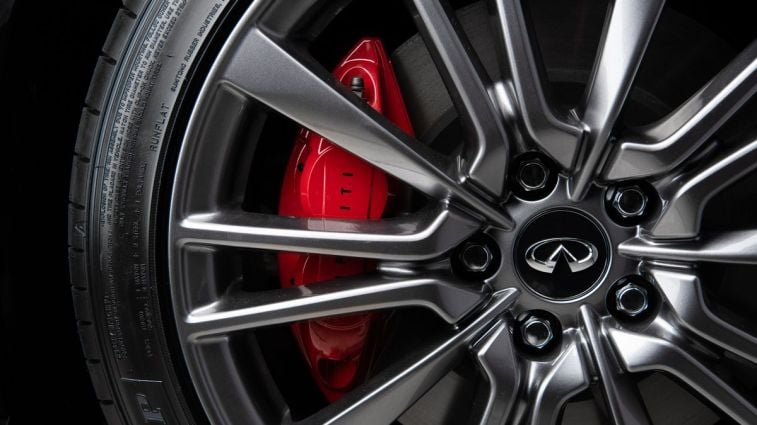Fast Information about Run-Flat Tires
It’s uncertain that drivers lie awake at evening agonizing over whether or not or not their subsequent automobile wants run-flat tires. Nevertheless, it’s a weightier choice than it might appear at first blush. Tires are an important single element on a automobile, truck, or SUV with regards to security, trip high quality, steering, and traction. “It’s the place the rubber meets the highway” is a well-liked saying for a motive. Even when the subject of run-flat tires hasn’t been occupying plenty of bandwidth in your noggin, it’s one thing to consider, notably with many new automobiles sporting them. We’ve offered leap hyperlinks in case you wish to skip forward.
What Is a Run-Flat Tire?


A run-flat tire is one with bolstered aspect partitions able to supporting a car’s weight in an air-loss occasion from a puncture. In different phrases, a run-flat tire’s construction is such that it will possibly hold driving after a puncture that may have flattened a daily tire. Some carmakers commissioned run flats from their tire suppliers to cut back a car’s weight, making it extra gasoline environment friendly. No spare tire, no jack, and no lug wrench interprets into much less weight and higher gasoline financial system.
RELATED: Bridgestone Turanza Tires Check for EVs
Can a Run-Flat Tire Nonetheless Operate Safely After a Sidewall Blowout?
Sure, within the very uncommon event of a sidewall blowout, the run-flat will nonetheless carry out its main operate of getting you house, to a restore store, or to a safer spot to alter the tire. In line with Ian McKenney, senior product supervisor, Bridgestone Americas, “Whether or not you run right into a state of affairs with a puncture or blowout within the middle, shoulder, or sidewall of the tire, you shouldn’t lose the integrity of the run-flat tire on the producer’s specified velocity and distance.”
How Lengthy Can You Drive on a Run-Flat Tire?
Most run-flats are engineered to drive about 50 miles after an air-loss incident, which provides them roughly the identical vary as these little space-saver doughnut spares discovered in lots of automobiles not outfitted with run-flat tires. Likewise, most run flats are rated at about 50 miles per hour after whole air loss, as are doughnut spares. “Make sure to examine every producer’s specs on how briskly and much you possibly can drive on run-flat tires as they differ,” McKenny mentioned.
RELATED: Automotive Tires Information: Every little thing You Have to Know
Do Run-Flat Tires Deal with Potholes Higher?
Run-flats don’t deal with potholes higher than standard tires. Quite the opposite, as a result of their sidewalls are a lot stiffer than a traditional tire, the chance of a aspect wall splitting or cracking from a extreme pothole hit is larger. Nevertheless, as Shopper Reviews factors out, run-flat tires supply a greater likelihood of having the ability to limp house or to a restore store after pothole harm.
Can You Repair a Run-Flat Tire?
No, there isn’t any fixing a run-flat tire. A reliable tire retailer or restore store received’t even try plugging a run-flat. Furthermore, the construction of a run-flat can masks further tire harm that may not be readily obvious. Consequently, driving on a “repaired” run-flat can be unsafe.
Are Run-Flat Tires Extra Costly Than Common Tires?
Usually, run-flats value anyplace from 25% to 100% extra to interchange than common tires. Nevertheless, it’s not merely the additional prices of executing the run-flat know-how driving up costs. As a result of there may be much less demand for run-flats, tire makers produce fewer run-flat variants. Much less competitors contributes to larger costs. Furthermore, we all the time advise that when changing a tire, on the very least, you additionally change the opposite tire on the identical axle. When run flats are concerned, that may run into some critical money.
Tip: The upper costs of run-flats make it much less doubtless for tire shops, particularly smaller retailers in rural places, to inventory a wide selection. If a blowout happens in a flippantly populated space, the retailer might should order the suitable substitute tire.
RELATED: Run-Flat Tires: Execs and Cons
Do Run-Flat Tires Put on Out Quicker?
Run-flat tires normally put on much less effectively than standard tires. In line with Shopper Reviews, on common, run-flats require substitute roughly 6,000 miles earlier than common tires.
How Typically Ought to I Change Run-Flat Tires?
As with standard tires, the timetable for changing run-flat tires varies by tire, car, and driver habits. In different phrases, it relies upon. For tires in any other case in good situation, tread depth determines when it’s time to interchange them. The motive force advocacy group AAA recommends a minimal tread depth of a minimum of 1/16th of an inch.
Tip: A down-and-dirty methodology for the 1/16th take a look at is to insert 1 / 4 with Washington’s head dealing with down into the groove between treads. For those who can see the highest of his head, it’s time to interchange your tires.
RELATED: Do My Tires Have to Be Changed?
Are Run-Flat Tires as Good as Common Tires?
Run-flat tires are designed to do one factor standard tires can’t: Preserve you driving after a full-air-loss puncture. In each different respect, they’re inferior to traditional tires. Run-flat tires:
- Value extra to interchange.
- Supply fewer substitute selections.
- Put on out sooner.
- Ship a rougher trip.
- Can’t be repaired.
Ought to You Purchase a Automotive with Run-Flat Tires?
There’s little question that if peace of thoughts is in your thoughts, run-flat tires might imply by no means once more altering a tire on the aspect of a busy freeway. That’s a strong motivator in our e book. In any other case, nonetheless, the arguments for standard tires are overwhelming.